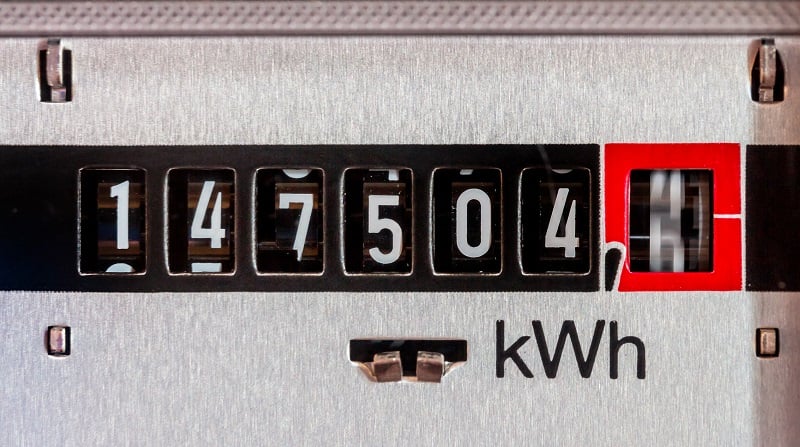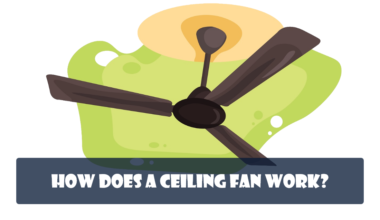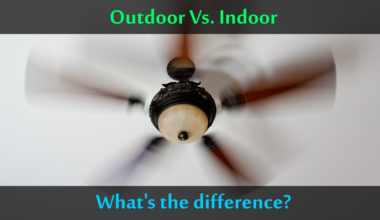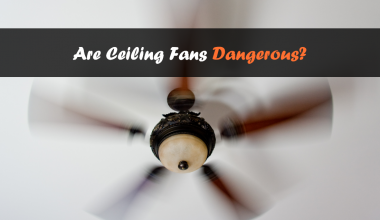Note that the products discussed on our site are independently selected by our editors. Your purchases through our recommendations may earn us a commission at no extra cost to you.

During the hot summer days, who doesn’t desire the indulgence of a cool breeze constantly comforting their skins? A lot of people commonly use ceiling fans in order to calm themselves during the scorching summer days. A ceiling fan makes use of an electric motor to rotate blades that evenly circulate air – causing evaporative cooling in its surrounding areas.
Most ceiling fans run at 50-80 watts, and will cost you around $0.006-$0.01 per hour at $0.12 per KWH. The cost largely depends on fan speed, efficiency, for how long you use it, and whether you use lights with it or not.
The reason why ceiling fans are so commonly used by most people is that they are both cost-effective and energy-efficient ways to keep cool. Check out some pros and cons of ceiling fans here if you are interested.
In this guide, we will do our best to find out how much do ceilings fans cost to run, and then break down the cost by hour, day, and month. And at the end, we’ll share some practical tips on how to save on electricity bills while using ceiling fans.
Do ceiling fans use a lot of electricity?
Short answer — no, they don’t. In fact ceiling fans on average take less than $0.01/hour to run – as we will see in this article. For example, Emerson Midway Eco ceiling fan will cost you only $18.92 at $0.12/kWh if you leave it running for a whole year. That’s luxury that costs pennies!
Check out our full review of the Emerson Midway Eco ceiling fan.
How much electricity does a fan use exactly?

In order to find how much electricity your fan uses, first off, you need to know the number of watts your ceiling fan makes use of. Then, you need to figure out the number of hours you use the fan on average every day. The wattage of ceiling fans usually ranges from 10 to 120 watts per hour.
In order to find out the price per hour to use the fan, you simply need to multiply the number of watts being used with the price per kWh electricity that your utility company charges you.
For example, if your ceiling fan has a capacity of having 60 watts and your utility company charges you $0.12 per kilowatt hour for electricity, the following will be the breakdown of electricity usage by the ceiling fan:
Per hour:
To know the cost of using the ceiling fan for one hour, the calculation will be as follows: 60 watts x $0.12 = 7.2
Since we are calculating in kilowatts, 1 kilowatt = 1000 watts. So, you need to divide 7.2 by 1000 as follows: 7.2 ÷ 1000 = 0.007
Therefore, your ceiling fan will cost you $0.007 for one hour of electricity usage.
Per day:
If you use your ceiling fan on an average of 6 hours every day, so one day’s electricity consumption by your fan will be as follows:
60 x 6 = 360 watt hours.
To calculate how much you will be charged for your ceiling fan for one day, you need to multiply the cost per hour by the average number of hours you use the fan. Using values from the example mentioned above, the calculation would be as follows:
$0.007 x 6 = 0.042
Therefore, your ceiling fan will cost you $0.042 each day.
Per month:
If your ceiling fan consumes an average of 360 watt hours every day, the calculation for a period of one month will be as follows:
360 x 30 = 10800
Since we are calculating in kilowatts, you need to divide 10800 by 1000 as follows: 10800 ÷ 1000 = 10.8 kilowatt hours. As 1 kilowatt hour = 1 unit, the total energy consumption by your ceiling fan for a month would also be 10.8 units.
To calculate how much you will be charged for your ceiling fan for one month, you need to multiply the total energy consumption for a month by the amount you are charged per kilowatt. The calculation will be as follows: 10.8 x $0.12 = $1.3
Therefore, your ceiling fan will cost you $1.3 each month.
To calculate the total cost of your ceiling fan for a year, the calculation will be as follows: $1.3 x 12 = $15.6
Which is cheaper to use: a fan, an AC unit, or a combination of both?
Before we jump into talking about the price differences between fans and air conditioners, let us discuss about their functions separately.
To begin with, the function of a ceiling fan is much simpler as compared to that of an air conditioner. A ceiling fan rotates its blades by the help of an electric motor and evenly distributes the air around its surrounding areas by making the air circulate in a fast manner. Ceiling fans help to cool you down by activating the natural cooling mechanism of your body – as the sweat from your skin evaporates.
On the other hand, an air conditioner is designed to do much more work in order to cool its surrounding area. An air conditioner makes use of chemicals that aid in passing the heat from inside your room to the atmosphere outside. The chemicals inside the air conditioner carry this out by converting from gas to liquid and back to gas in a relatively fast manner.
Now let us take a look into the differences between the electricity usages of a fan and an air conditioner. To start off, a ceiling fan generally ranges from 10 to 120 watts of power. On the other hand, an air conditioner generally ranges from 750 to 3500 watts of power. As you can notice the huge difference between the two, you can already predict which one would be cheaper to use. Naturally, the higher the electricity usage, the higher the price. Therefore, as the amount of electricity a ceiling fan uses is much less than that of an air conditioner, a ceiling fan is definitely much cheaper to use.
To discuss the costs further in details, a decent ceiling fan would require 30 watts of power to run, whereas a decent air conditioner would require around 1.2 kilowatts of power to run. Using a ceiling fan of 30 watts power for three hours would cost you only around 1 cent, whereas using an air conditioner of 1.2 kilowatts for an hour would cost you around 14 cents. Therefore, the difference between the costs of the two is definitely a lot.
Even though using ceiling fans cost much cheaper than air conditioners, a lot of people still prefer to use an air conditioner. The reason for this is because air conditioners actually cool the temperature of a room, whereas ceiling fans only cool your skin instead of cooling the room. As a result, even if you keep a ceiling fan running for a long period of time, it will not alter the temperature of the room; rather, it will only waste electricity.
Therefore, in order to cut electricity bills while efficiently cooling the room, a lot of people use a combination of an air conditioner and a ceiling fan – instead of individually using either of them for prolonged hours.
In a nutshell, while using an air conditioner is the most efficient way to cool your room, using a ceiling fan is the cheapest to use.
However, using a combination of both a ceiling fan and an air conditioner is the most efficient way to cool your room faster. Because, this way you will have the luxury of making the temperature of your room actually cooler while being able to turn up the thermostat a few degrees higher (to save money) as the ceiling fan will evenly distribute the cool air throughout the room.
Tips on how to save electricity while using a ceiling fan
Here we want to share some practical tips on how you can save some extra bucks while using a ceiling fan. Here they go —
Check the direction that your fan rotates in: This is a very significant factor in terms of saving electricity while using a fan – the efficiency will be poor if the fan rotates in the incorrect direction. During summer time, set the direction of your fan so that the air moves downwards – it is usually the counterclockwise setting on most ceiling fans. During winter time, set your fan so that the air is sucked up from beneath the ceiling fan towards the ceiling – it is usually the clockwise setting on most ceiling fans.

Switch off the fan when you go out of the room: Even though ceiling fans do not use a lot of electricity and will not cost you huge amounts of money to operate, why should you waste electricity or your money when you can save them? If you are not staying under the fan, always remember to switch it off as you exit the room – in order to save electricity that could increase your expenses.
Use ceiling fans that do not contain any light fixtures: Even though ceiling fans that contain light fixtures appear to be very attractive, they are not as energy-efficient as ceiling fans without any light fixtures. However, if you are really drawn to ceiling fans with light fixtures, you can go for the ones with LED light bulbs – they are energy-saving light bulbs. They use much less electricity compared to traditional incandescent light bulbs.

Ceiling fans come with all sorts of blade options – 3 blades, 4 blades, 5 blades, etc. Want to know how many blades are best in a ceiling fan? Read on to find out.
Conclusion: Are ceiling fans efficient?
In conclusion, ceiling fans are very safe, efficient, and cost-effective ways to cool yourself. As they require very little electricity to run, they will cost you very little – especially when compared to an AC unit.
Through the practical explanations and calculations provided in this article, we hope that you have come across clear-enough reasons as to why ceiling fans are efficient ways to constantly provide your skin with coolness – without the worry of them costing you an arm and a leg! If you are still not convinced, we have a separate article showing you a number of more reasons to install ceiling fans.
Next read
Will a Ceiling Fan Keep Mosquitoes Away? Here’s How To Do It!
Comparing electric fan types: Tower Fans Vs Stand Fans Vs Ceiling Fans Vs Floor Fans








Conversation
No Comments here